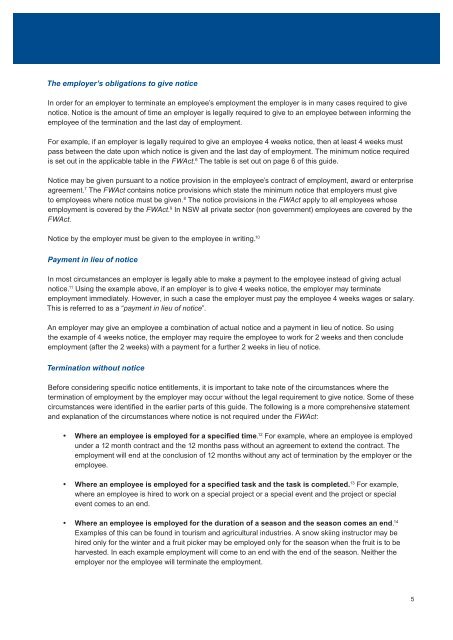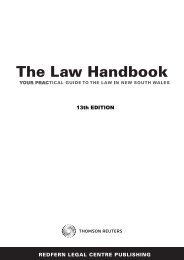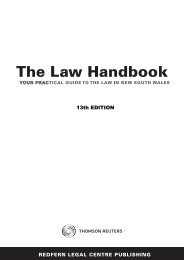Guide to termination and unfair dismissal rights of - Legal ...
Guide to termination and unfair dismissal rights of - Legal ...
Guide to termination and unfair dismissal rights of - Legal ...
- No tags were found...
Create successful ePaper yourself
Turn your PDF publications into a flip-book with our unique Google optimized e-Paper software.
The employer’s obligations <strong>to</strong> give noticeIn order for an employer <strong>to</strong> terminate an employee’s employment the employer is in many cases required <strong>to</strong> givenotice. Notice is the amount <strong>of</strong> time an employer is legally required <strong>to</strong> give <strong>to</strong> an employee between informing theemployee <strong>of</strong> the <strong>termination</strong> <strong>and</strong> the last day <strong>of</strong> employment.For example, if an employer is legally required <strong>to</strong> give an employee 4 weeks notice, then at least 4 weeks mustpass between the date upon which notice is given <strong>and</strong> the last day <strong>of</strong> employment. The minimum notice requiredis set out in the applicable table in the FWAct. 6 The table is set out on page 6 <strong>of</strong> this guide.Notice may be given pursuant <strong>to</strong> a notice provision in the employee’s contract <strong>of</strong> employment, award or enterpriseagreement. 7 The FWAct contains notice provisions which state the minimum notice that employers must give<strong>to</strong> employees where notice must be given. 8 The notice provisions in the FWAct apply <strong>to</strong> all employees whoseemployment is covered by the FWAct. 9 In NSW all private sec<strong>to</strong>r (non government) employees are covered by theFWAct.Notice by the employer must be given <strong>to</strong> the employee in writing. 10Payment in lieu <strong>of</strong> noticeIn most circumstances an employer is legally able <strong>to</strong> make a payment <strong>to</strong> the employee instead <strong>of</strong> giving actualnotice. 11 Using the example above, if an employer is <strong>to</strong> give 4 weeks notice, the employer may terminateemployment immediately. However, in such a case the employer must pay the employee 4 weeks wages or salary.This is referred <strong>to</strong> as a “payment in lieu <strong>of</strong> notice”.An employer may give an employee a combination <strong>of</strong> actual notice <strong>and</strong> a payment in lieu <strong>of</strong> notice. So usingthe example <strong>of</strong> 4 weeks notice, the employer may require the employee <strong>to</strong> work for 2 weeks <strong>and</strong> then concludeemployment (after the 2 weeks) with a payment for a further 2 weeks in lieu <strong>of</strong> notice.Termination without noticeBefore considering specific notice entitlements, it is important <strong>to</strong> take note <strong>of</strong> the circumstances where the<strong>termination</strong> <strong>of</strong> employment by the employer may occur without the legal requirement <strong>to</strong> give notice. Some <strong>of</strong> thesecircumstances were identified in the earlier parts <strong>of</strong> this guide. The following is a more comprehensive statement<strong>and</strong> explanation <strong>of</strong> the circumstances where notice is not required under the FWAct:• Where an employee is employed for a specified time. 12 For example, where an employee is employedunder a 12 month contract <strong>and</strong> the 12 months pass without an agreement <strong>to</strong> extend the contract. Theemployment will end at the conclusion <strong>of</strong> 12 months without any act <strong>of</strong> <strong>termination</strong> by the employer or theemployee.13• Where an employee is employed for a specified task <strong>and</strong> the task is completed. For example,where an employee is hired <strong>to</strong> work on a special project or a special event <strong>and</strong> the project or specialevent comes <strong>to</strong> an end.Where an employee is employed for the duration <strong>of</strong> a season <strong>and</strong> the season comes an end• . 14Examples <strong>of</strong> this can be found in <strong>to</strong>urism <strong>and</strong> agricultural industries. A snow skiing instruc<strong>to</strong>r may behired only for the winter <strong>and</strong> a fruit picker may be employed only for the season when the fruit is <strong>to</strong> beharvested. In each example employment will come <strong>to</strong> an end with the end <strong>of</strong> the season. Neither theemployer nor the employee will terminate the employment.5
















